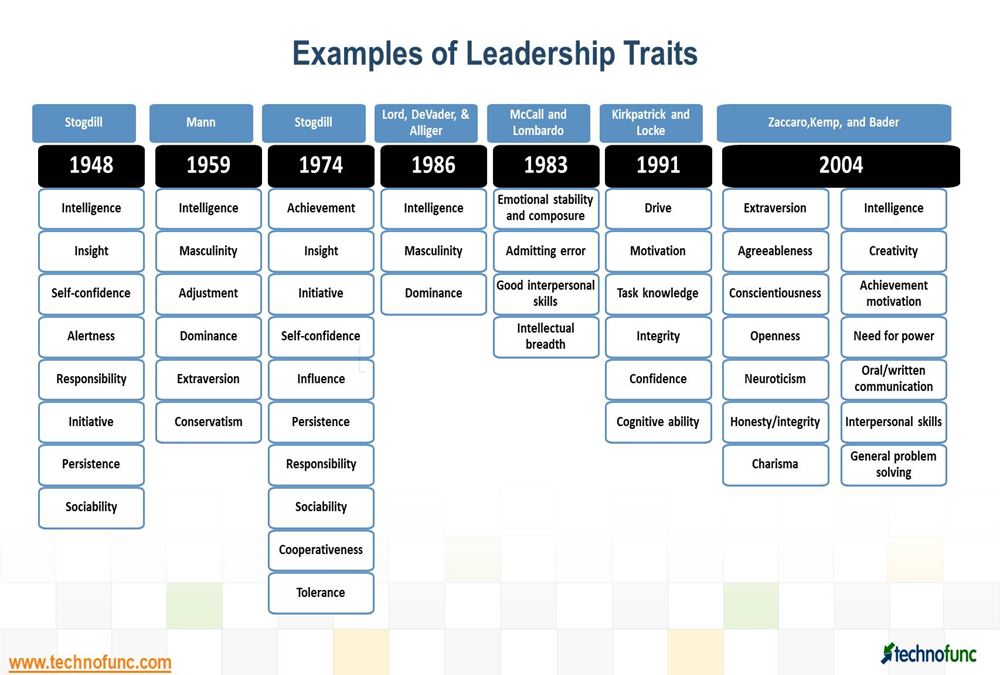- Home
- Business Processes
- Industry Knowledge
- Aerospace Industry
- Automotive Industry
- Banking Domain
- BFSI Industry
- Consumer/ FMCG Industry
- Chemicals Industry
- Engineering & Construction
- Energy Industry
- Education Domain
- Finance Domain
- Hospitality Domain
- Healthcare Industry
- Insurance Domain
- Retail Industry
- Travel and Tourism Domain
- Telecom Industry
- Leadership Skills
- eLearning
- Home
- Leadership
- Change Management
- Trait Theory of Leadership
Trait Theory of Leadership
Trait Theory of Leadership is based on the assumption that people are born with inherited traits and some traits are particularly suited to leadership. The theory aims to discover specific leadership & personality traits and characteristics proven to predict the likelihood of success or failure of a leader.
What are Personality Traits?
The trait approach to personality is one of the major theoretical areas in the study of human personality and is focused on differences between individuals. The trait approach was one of the first systematic attempts to study leadership. The combination and interaction of various traits forms a personality that is unique to each individual. Trait theory is focused on identifying and measuring these individual personality characteristics known as Traits.
Traits: Also called dispositions, Traits can be defined as habitual patterns of behavior, thought, and emotion. Traits are relatively stable over time, differ across individuals and influence behavior. Traits are external behaviors that emerge from internal beliefs and processes.
What is Trait Theory of Leadership?
Trait Theory of Leadership is based on the assumption that people are born with inherited traits and some traits are particularly suited to leadership. People who make effective leaders have the right (or sufficient) combination of traits and great leaders has some common personality characteristics. Trait theories help us identify traits and dispositions that are helpful when leading others. This theory as described by Kelly (1974) attempts to classify what personal characteristics such as physical, personality and mental, are associated with leadership success. Trait theory relies on research that relates various traits to the success of a leader.
Quotes on Traits:
“Leadership consists not in degrees of technique but in traits of character; it requires moral rather than athletic or intellectual effort, and it imposes on both leader and follower alike the burdens of self-restraint.” - Lewis H. Lapham
“The screenwriters I know share a few personality traits and one of them is anxiety.” - Tony Gilroy
“I think in the end, when you're famous, people like to narrow you down to a few personality traits. I think I've just become this ambitious, say-whatever's-on-her-mind, intimidating person. And that's part of my personality, but it's certainly not anywhere near the whole thing.” - Madonna Ciccone
“The moment a person forms a theory, his imagination sees in every object only the traits which favor that theory” - Thomas Jefferson
Overview of Trait Theory of Leadership:
Early research on leadership was based on the psychological focus of the day, which was of people having inherited characteristics or traits. The trait theory of leadership focused on analyzing mental, physical and social characteristic in order to gain more understanding of what is the characteristic or the combination of characteristics that are common among leaders. There have been many different studies of leadership traits and attention was put on discovering these traits, often by studying successful leaders, but with the underlying assumption that if other people could also be found with these traits, then they, too, could also become great leaders.
Advantages of Trait Theory of Leadership:
The trait theory is naturally pleasing theory and gives constructive information about leadership. Lot of research has validated the foundation and basis of the theory and it can be applied by people at all levels in all types of organizations. Managers can utilize the information from the theory to evaluate their position in the organization and to assess how their position can be made stronger in the organization. It serves as a yardstick against which the leadership traits of an individual can be assessed and individuals can get an in-depth understanding of their identity and the way they will affect others in the organization. This theory makes the manager aware of their strengths and weaknesses and thus they get an understanding of how they can develop their leadership qualities. It gives a detailed knowledge and understanding of the leader element in the leadership process.
Examples of Leadership Traits:
A lengthy list of traits has been made to describe an effective leader in terms of certain characteristics. Given below is outcome of studies on leadership traits and characteristics with reference to timelines in terms of years:

Criticism / Arguments against - The Trait Theory of Leadership:
Many arguments are made against the leadership theory of traits and it has some inherent limitations as during the 1930s the field of Psychometrics was in its early years. The greatest argument is that if particular traits are key differentiator of leadership, then how do we explain people who possess these qualities but are not leaders? This question is one of the difficulties in using trait theories to explain leadership.
These characteristics according to some people are considered valid indicators of successful leaders, but if you compare leaders by various physical personality and intelligence traits, you may find very little agreement on these. Some findings point out to the fact that leaders are intelligent individuals. But they do not provide any clue as to whether leaders are brighter than their followers or are as close to them in intelligence.
This theory is quite complex and there is bound to be some subjective judgment in determining who is regarded as a ‘good’ or ‘successful’ leader and many of these factors are situational related factors. The followers have a significant effect on the job accomplished by the leader. Trait theory completely ignores the followers and the situations that also help a leader to be successful. To be more objective, traits of the person as well as demand of the situation together determine the effectiveness of the leader.
Some of the personality traits are overlapping with each other. Therefore, you need to be cautious in stating, personality or any other characteristic as a cause of successful leadership. You must ask the questions: Who is a successful leader? Is he far superior physically? Is he far brighter? Is he more mature as a person? Is he more motivated to achieve his goal? Does he have more consideration for his followers? Etc.
Moreover the list of possible traits tends to be very long and personality traits measurement weren't reliable across studies. More than 100 different traits of successful leaders in various leadership positions have been identified. These descriptions are simply generalities and there exists disagreement over which traits are the most important for an effective leader. This theory does not offer explanations between the relation of each characteristic and its impact on leadership. Some of the traits may describe a successful leader but predicting successful leaders on the basis of traits alone is not a correct approach.
Stogdill in 1948, suggested that no consistent set of traits differentiated leaders from non-leaders across a variety of situations implying that an individual with certain traits who has been successful in one situation might not be as effective in another situation and this led to researchers concluding that traits were to be considered as relative to the requirements of the situation.
Related Links
You May Also Like
-
The open systems model of leadership acknowledges the influence of the environment on organizations. An open system regularly exchanges feedback with its external environment. The environment also provides key resources that are necessary to sustain and lead to change and survival. Leadership in an open system should focus on influence, open communication, and patterns to control expanding the number of variables created by external dynamics.
-
Jung first introduced his personality theory and explained that all humans have a natural impulse to relate meaningfully to the world through productive work and people through significant relationships. He used four psychological functions - thinking and feeling (rational functions) and sensation and intuition (irrational functions). He also used introversion and extraversion and its impact on appropriate leader behaviors.
-
Authentic leadership is a new approach to leadership in which leaders are genuine, self-aware, transparent, build honest relationships, and work on an ethical foundation. Authenticity is one of the core values of leadership. Authentic leaders have truthful self-concepts and they inspire by promoting openness by acting in a real, genuine, and sincere way. Authenticity requires self-awareness and the ability to act in accordance with one's true self.
-
The two-factor theory also known as Herzberg's motivation-hygiene theory and dual-factor theory. This motivator-hygiene theory states that certain factors cause job satisfaction whereas certain separate factors cause dissatisfaction in the workplace. An organization can adjust these factors to influence motivation. These factors are respectively termed as motivators and hygiene factors.
-
Charismatic leadership is a trait-based leadership theory where the leaders act as visionary driven by their convictions and motivate their followers to work towards common vision using their charm and persuasiveness. These charismatic leaders act as role models and exhibit extraordinary characteristics that inspire devotion and motivation in followers to persuade change. Leaders are able to cultivate a profound sense of trust with the group of followers.
-
In emergent leadership, the leader is not appointed or elected to the leadership role but emerges as the leader as he is perceived by others over time as a result of the group's interaction. A person steps up as the leader over time by taking on tasks voluntarily, helping others complete their tasks better, and building consensus among groups.
-
Rensis Likert studied the patterns and styles of managers and developed four management systems known as Likert's management systems. These styles developed by him are known as Likert management systems. System 1 - Exploitative Authoritative; System 2 - Benevolent Authoritative; System 3 - Consultative and System 4 - Participative.
-
Transactional Theory of Leadership
Transactional leadership theory is based on the concept of rewards and punishments. The transactional management approach assumes that the desires of the leader and follower are different and leaders give followers something in exchange for getting something they want. Transactional leaders expect followers to be compliant and focuses on structure, instruction, monitoring, organization, or performance to get tasks completed on time.
-
Contingency Theories in Action
Contingency theory suggests matching the best leader to a specific situation based on situational factors and the leadership style. The practical application of theory can be done in various ways. The workplace example is to determine the best candidate for a given set of requirements using the LPC score. Applying the model to determine a leader's ability to adapt in the scenario of a new project etc..
-
Socio-technical theory of leadership focus on the presence of two subsystems in every organization, the interrelatedness of social and technical aspects of an organization. Theory pertains to the social aspects of people and technical aspects of an organization, which means structure and processes within the organization.
Explore Our Free Training Articles or
Sign Up to Start With Our eLearning Courses

About Us
Learning
© 2023 TechnoFunc, All Rights Reserved










